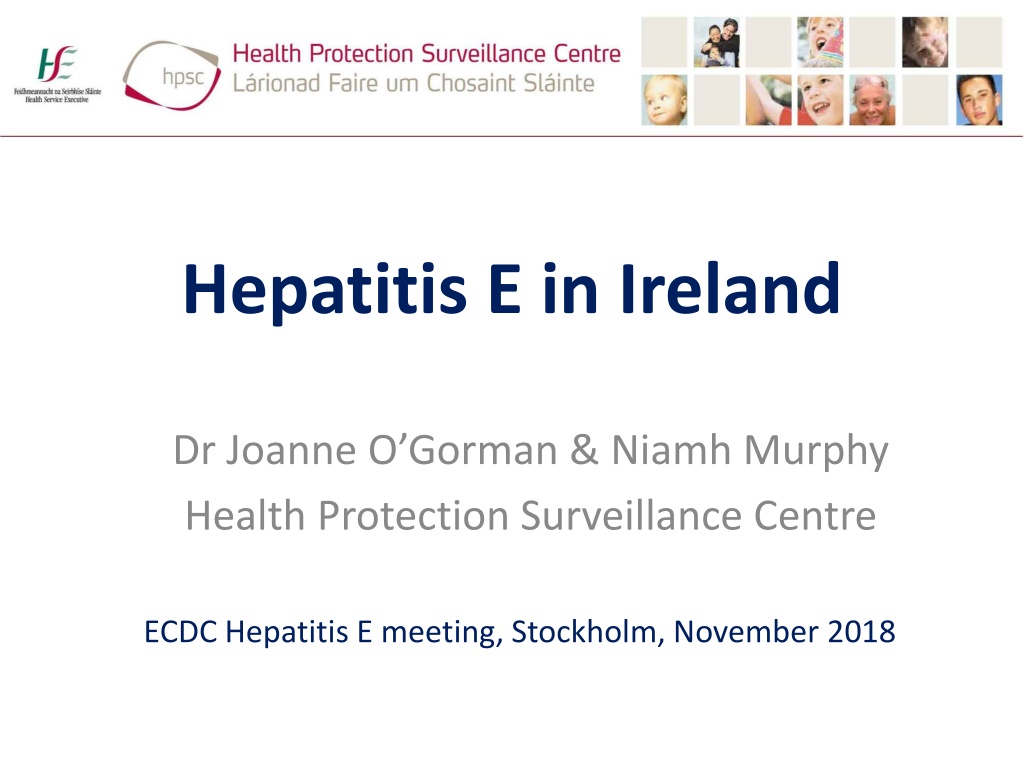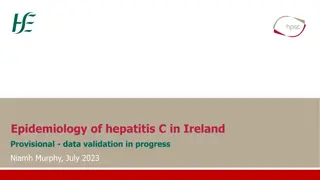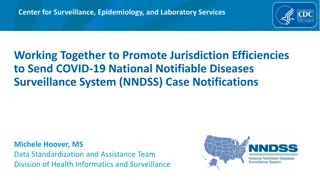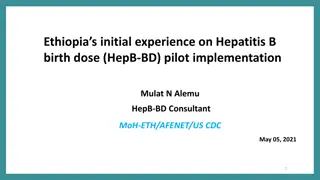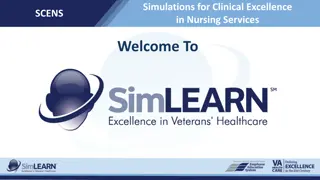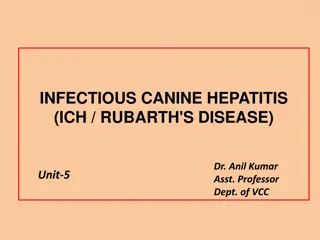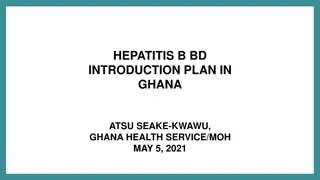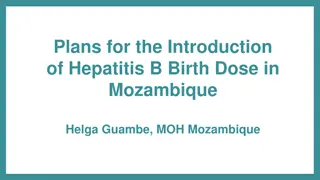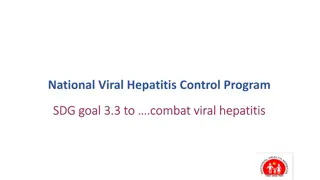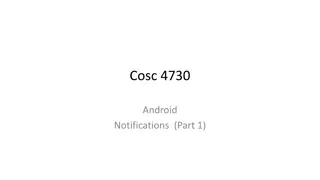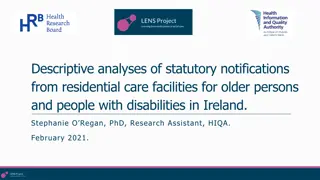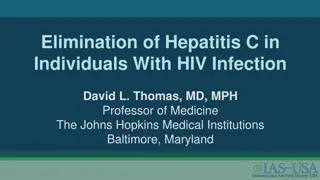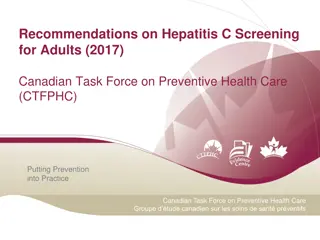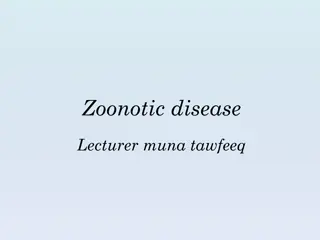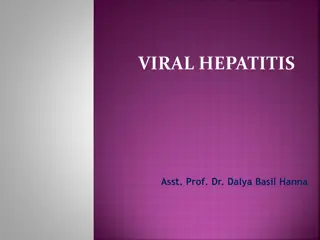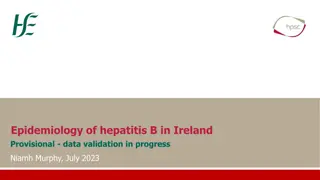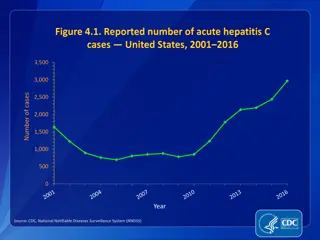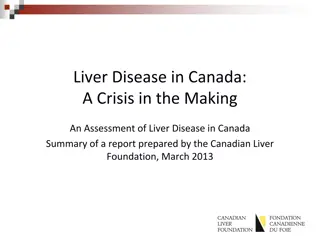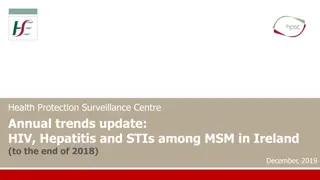Hepatitis E Surveillance and Notifications in Ireland
The surveillance and notification of Hepatitis E cases in Ireland have been detailed, including the introduction of universal blood donor screening, notifiable disease status, and enhanced surveillance measures. The data shows trends in notifications, blood donor screening results, clinical cases, age and sex distribution, and the implementation of enhanced surveillance for Hepatitis E.
Download Presentation

Please find below an Image/Link to download the presentation.
The content on the website is provided AS IS for your information and personal use only. It may not be sold, licensed, or shared on other websites without obtaining consent from the author. Download presentation by click this link. If you encounter any issues during the download, it is possible that the publisher has removed the file from their server.
E N D
Presentation Transcript
Hepatitis E in Ireland Dr Joanne O Gorman & Niamh Murphy Health Protection Surveillance Centre ECDC Hepatitis E meeting, Stockholm, November 2018
Notifiable disease in Ireland January 2016 Universal blood donor screening for hepatitis E commenced in Ireland 15 December 2015 - Hepatitis E added to list of notifiable diseases All confirmed cases notifiable by clinicians and laboratories Notification data collated nationally by HPSC Hepatitis E Case definition (only laboratory confirmed cases notifiable) Acute case At least one of the following two: Hepatitis E virus IgM and IgG antibody positive Detection of hepatitis E virus RNA Chronic case Hepatitis E virus RNA persisting for at least 3 months
Hepatitis E (HEV) notifications, 2016 and 2017 Total notifications = 90 in 2016, 54 in 2017 Blood donor screening by IBTS, n = 51 (35%) Median age of IBTS cases = 37 years (range: 18-66 ) 0.05% of male blood donors HEV positive compared to 0.03% females (no statistical diff) Clinical cases, n = 93 (65%) Median age of clinical cases = 54 years (range: 15-84) 58% clinical cases were male (no statistical diff) Higher clinical notification rate in males 50+ Patient type known for 65% clinical cases 37% hospital inpatients Annual notification rate clinical cases: 1.2/100,000 in 2016 (n=56) 0.8/100,000 in 2017 (n=37) % blood donors positive: 0.04% in 2016 0.03% in 2017
Number of clinical & IBTS HEV cases in Ireland, Q1 2016 Q3 2018 31 Cases detected through IBTS blood donor screening 35 Number of notifications of hepatitis E 30 28 Clinical cases (attended GP or hospital with symptoms) 25 22 20 19 20 18 15 15 15 12 9 10 8 5 0 Q1 Q2 Q3 Q4 Q1 Q2 Q3 Q4 Q1 Q2 Q3 2016 2017 2018 Year and quarter
HEV notifications by age and sex in Ireland, 2016 and 2017
Enhanced surveillance - Hepatitis E Enhanced surveillance of clinical cases introduced 1 July 2016 1 yr trial period IBTS reported enhanced data for 18 month period (Jan 2016 - June 2017) Departments of Public Health or IBTS interviewed cases Clinical features, exposures and risk factors for severe disease Enhanced data collection forms completed for 67 out of 120 cases (56%) notified Jan 2016 to end June 2017 Enhanced surveillance discontinued July 2017
% with each food exposures in the 9 weeks prior to illness/diagnosis (n=64) One or more pork products 97 89 Bacon 84 Pork sausages 81 Pork meat 73 Sliced ham, pre-packed 63 Cured pork e.g. salami 61 Ham, off the bone/joint 59 Black pudding 20 Pork pate 5 Pork liver 3 Pork pie 0 Other pork offal 14 Other pork products 2 Undercooked pork 45 Shellfish 18 Game 0 20 40 60 80 100
% with each symptom Clinical IBTS Symptoms p-value Num 20 9 1 6 5 9 4 10 11 12 6 4 11 % Num 11 2 2 4 0 2 0 0 1 1 0 0 7 % Any symptoms Fever Diarrhoea Abdominal pain Headaches Nausea Vomiting Joint pain Dark urine Jaundice Weakness of limbs/tingling Other neurological symptoms Other symptoms 80.0 39.1 6.7 26.1 22.7 39.1 17.4 45.5 47.8 50.0 27.3 22.2 55.0 26.8 4.9 4.9 9.8 0.0 4.9 0.0 0.0 2.4 2.4 0.0 0.0 17.1 <0.001 <0.001 0.792 0.084 0.001 <0.001 0.006 <0.001 <0.001 <0.001 <0.001 0.002 0.002
Discontinuation of enhanced surveillance why? Very consistent pattern of food consumption reported Need case control study to determine if consumption of these food items differs between cases and the general population Data collection creating additional workload for already over-burdened public health staff worthwhile? Revisit with more specific form guided by research into food chain?
FoVIRA Foodborne Viruses in Ireland farm to fork Investigation, Identifying Risk and mitigation Approaches for Hepatitis E Virus, Hepatitis A Virus, Norovirus & Sapovirus 1. To investigate the epidemiology of Hepatitis E Virus in Irish pigs and the occurrence of Hepatitis E Virus in Irish pigmeat products . 2. To determine the occurrence of Hepatitis E Virus, Hepatitis A Virus Norovirus and Sapovirus, in Irish oysters and berries. 3. To genetically characterise Hepatitis E Virus, Hepatitis A Virus, Norovirus and Sapovirus isolates and to determine the phylogenetic relationship between isolates detected in Irish pigs, shellfish, berries and those from human clinical samples. 4. To conduct an exposure assessment of the risk posed to consumers by Hepatitis E Virus, Hepatitis A Virus, Norovirus & Sapovirus in the food chain and to identify appropriate risk mitigation measures Research Funding: Department of Agriculture Food and the Marine Institutional Research Measure 15F724
The Irish experience Impact of universal blood donor screening & change in laboratory testing practice on surveillance data Increased clinical awareness of HEV in recent years Notification includes a case definition for chronic infection but not frequently utilised Molecular epidemiology: Genotype 3 predominantly 3c Enhanced surveillance pilot useful but limited national food consumption data & no case control studies Focus on risk in the food chain FoVIRA study
Acknowledgements HPSC IBTS Lelia Thornton Patricia Garvey Fiona Boland Niamh O Flaherty CVRL NVRL Conor Davin Louise Britton Eoin Ryan Charlene Benett Cillian DeGascun Suzie Coughlan Jonathan Dean Allison Waters Linda Dunford Marine Institute Sinead Keaveney Amy Fitzpatrick
